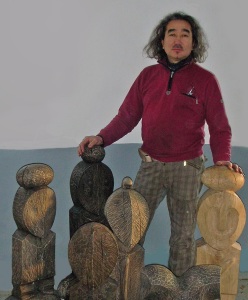
By Janet Duignan
Twenty-thousand years ago Cro-Magnons hunted in the Vézère Valley in what is now Dordogne. They ate reindeer. They encountered bulls, felines, equines, stags, bison, bears. They drew images of these animals, creating the concentration of decorated caves found near the village of Les Eyzies-de-Tayac, and, most famously, at Lascaux. They wore their hides and used bone needles and hide laces to sew on ivory buttons.
Nearby, hidden in the Dordogne hills in the village of Fanlac, a 30-minute drive north of Les Eyzies, a 15-minute drive west of Lascaux, another ancestral type of hide-work is going on. Not as old as the Cro-magnon cave paintings, this craftsmanship draws on an ancient tradition practiced by our fellow Homo sapiens sapiens, in Siberia.
Tucked away among the houses on one of the narrow lanes of Fanlac, just off the village square with its 12th century fortified church, is a workshop designated by the sign announcing “Leather Artisan” and marked with two fish. It’s a dark studio with display cases and long wooden tables, where a man is hard at work making leather goods—bags, belts and cases—that incorporate what look, at first glance, like snake skin.
We enter, intrigued, and were soon transported away from the tourist attraction of the surrounding village and into the story of a largely forgotten native Siberian tribe.
We ask about the snake skin.
“Not at all,” laughs the artisan, Kristof Mascher, holding up what is actually a fish skin. “I use only the skins of sturgeon and salmon that have been farmed for food and then tanned using only vegetable products and dyes. It is a very ecologically-friendly product.”

In south-east Siberia, he explains, an indigenous people called the Nanais developed a specialized tanning technique for fish skin which allowed them to make waterproof clothing.
“My grandfather’s grandfather was a merchant who travelled round the villages collecting examples of native costumes,” Mascher says. “He subsequently donated them to museums in Europe. My uncle, who was researching his life, came across a descendent of this tribe, Anatol Donkan, who is now a renowned artist in the field of native sculpture. Following extensive research and experimentation, Anatol managed to improve on the Nanais’ technique of tanning fish skin, as the original method produced skins that were partly raw and still smelled of fish. In collaboration with a Swiss specialist, Anatol has worked to improve and modernize the ancient method and has succeeded in producing a tear-proof fish skin leather using only plant extracts.”

Today there are 10,000 surviving Nanais, but only the oldest ones still speak their own language. Their culture has mostly been annihilated and forgotten. Donkan, who now lives in Viechtach, Gremany, has worked tirelessly to restore their place in history and to give them back one of the old traditions.
Donkan produces the fish skin leather using his unique technique and Mascher uses them in his exquisite handcrafted creations. Mascher demonstrates the superiority of Donkan’s leather by showing us other skin, this time processed with chemicals in a dangerous procedure that leaves the fish skin flabby and a uniform dull grey.
“I inlay the fish skin leather, using its unique coloring, design and shading to produce different effects,” explains Mascher. “The designs I make on the bags are my little homage to nature: leaves, fish, flowers, or the sun, for example.”
The result is beautiful and unique. See some of Mascher’s creations here. See some of Donkan’s creations here.
Mascher spends some time each year taking parties canoeing down Mongolian rivers. He was born in Sweden but his mother was German, so he mostly sells his work either from his atelier or at annual craft fairs in Germany. He left home as a young man to work his way through France and eventually learned his craft as an apprentice to a Parisian leather craftsman who later moved to the Dordogne. He made his home here and now his eldest son is working with him, learning the business, carrying on the tradition brought from another time, another place.
Find out more about Kristof Mascher’s work here.
Find out more about Anatol Donkan’s work here.
© 2014, Janet Duignan
Janet Duignan is a British writer and journalist living in Dordogne

